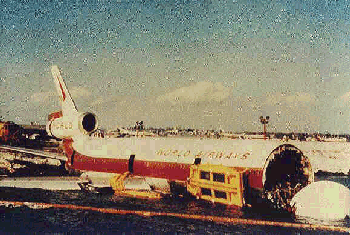
Date: January 23, 1982 Type: DC-10-30CF Registration: N113WA Operator: World Airways, Inc. Where: Boston-Logan International Airport, Boston, Massachusetts Report No. NTSB-AAR-82-15 Report Date: December 15, 1982 Pages: 109 On January 23, 1982, World Airways, Inc., Flight 30H, a McDonnell Douglas DC-10-30, was a regularly scheduled passenger flight from Oakland, California, to Boston, Massachusetts, with an en route stop at Newark, New Jersey. Following a nonprecision instrument approach to runway 15R at Boston-Logan International Airport, the airplane touched down about 2,500 feet beyond the displaced threshold of the 9,191-foot usable part of the runway. About 1936:40, the airplane veered to avoid the approach light pier at the departure end of the runway and slid into the shallow water of Boston Harbor. The nose section separated from the forward fuselage in the impact after the airplane dropped from the shore embankment. Of the 212 persons on board, two are missing and presumed dead. The others evacuated the airplane safely, but with some injuries. The weather was 800-foot overcast, 2 t/2-mile visibility, with light rain and fog. The temperature was 38! with the wind from 165! at 3 kns. The surface of runway 15R was covered with rain, hard-packed snow, and glaze ice. At 1736, 2 hours before the accident, runway braking was reported by a ground vehicle as "fair to poor;" subsequently, several pilots had reported braking as poor, and one pilot had reported braking as "poor to nil" in the hour before the accident. The National Transportation Safety Board determines that the probable cause of this accident was the pilot landed the airplane without sufficient information as to runway conditions on a slippery, ice-covered runway, the condition of which exceeded the airplane's stopping capability. The lack of adequate information with respect to the runway was due to the fact that (1) the FAA regulations did not provide guidance to airport management regarding the measurement of runway slipperiness under adverse conditions; (2) the FAA regulations did not provide the flightcrew and other personnel with the means to correlate contaminated surfaces with airplane stopping distances; (3) the FAA regulations did not extend authorized minimum runway lengths to reflect reduced braking effectiveness on icy runways; (4) the Boston-Logan International Airport management failed to exercise maximum efforts to assess and improve the conditions of the ice-covered runways to assure continued safety of heavy jet airplane operations; and, (5) tower controllers failed to transmit available braking information to the pilot of Flight 30H. Contributing to the accident was the failure of pilot reports on braking to convey the severity of the hazard to following pilots. The pilot's decision to retain autothrottle speed control throughout the flare and the consequent extended touchdown point on the runway contributed to the severity of the accident.
